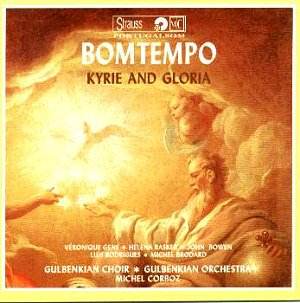Bomtempo had risen to the position of first oboist
in the band at the Portuguese Royal Court but following political unrest
left first for Paris and later for London. It was in the French capital,
in 1818, that he wrote the Kyrie and Gloria and he subsequently
revised it in Lisbon in 1821 for its first performance, after his return
from self-imposed exile. I know Bomtempo mainly through his piano works
and it has been enjoyable to listen to the Kyrie and Gloria, works that
may not be formally or musically over-ambitious but which, within their
compass, still manage to be lyrical and are full of some refined orchestral
pointing.
The Kyrie is a reflective, somewhat tense work with
an ascending and descending bass line, aspirant and which builds in
volume and fervour. Though essentially homophonic there is plenty to
stimulate both vocally and instrumentally. The Gloria opens with a strongly
punctuated drive, the soloists making their presence felt, with plenty
of expressive choral moulding, supported by apposite diminuendi. The
string pointing in the Laudamus Te is reminiscent of Haydn in its elegance
and a fine duet between soprano Véronique Gens and tenor John
Bowen is supported by strong choral "pillars", well crafted
and dramatically cogent. Bowen is fine but Gens is the standout here.
In the succeeding Domine Deus Luís Rodrigues and Michel Brodard
are accompanied by strings, bassoon and trumpets; itís the close of
the movement in which resides the greatest surprise Ė a choral section
of beguiling plangency. Qui tollis is a trio for soprano, contralto
and bass. Italianate and long Ė in this performance itís over sixteen-minutes
it doesnít in truth possess quite the level of thematic material to
sustain that breadth but there are charming things here. The piping
clarinet for example makes an important appearance, At 3.50 the soloists
sing over a clarinet and pizzicato basses; the clarinet adds warmth
and the movement here becomes suffused in Italianate lyricism. Mezzo
Helena Rasker has a well-modulated depth and more importantly focuses
and blends her tone with Gens and Brodard. The strong edit as the movement
ends is probably due to audience noise and is reflective, I guess, of
the fact that this is a live performance recorded in the auditorium
of the Gulbenkian Foundation (the following day was presumably a repeat
performance or was used for patching, the notes arenít clear on the
point). Qui sedes generates a fine sense of momentum, a lively curve
of melody, one that becomes increasingly fervent with sure choral contributions.
The Cum Sancto Spiritu is performed with only one of its sections so
whilst itís an affirmatory way in which to end itís also very short
at 1.51.
So a successful work and performance, the first of
modern times. The experienced Michel Corboz directs with real sensitivity
not least in the important matter of the orchestral part, which because
it generally abjures monumental tuttis, relies instead on colouristic
inflection for maximum effect. Thus chamber sonorities predominate as
well as concertante sections. The choruses are involved and active ingredients
of Bomtempoís pattern and the Gulbenkian choir acquit themselves well.
Itís not a masterpiece and its Haydnesque character is very evident
but thatís no reason at all not to investigate a charmingly assured
work such as this.
Jonathan Woolf
